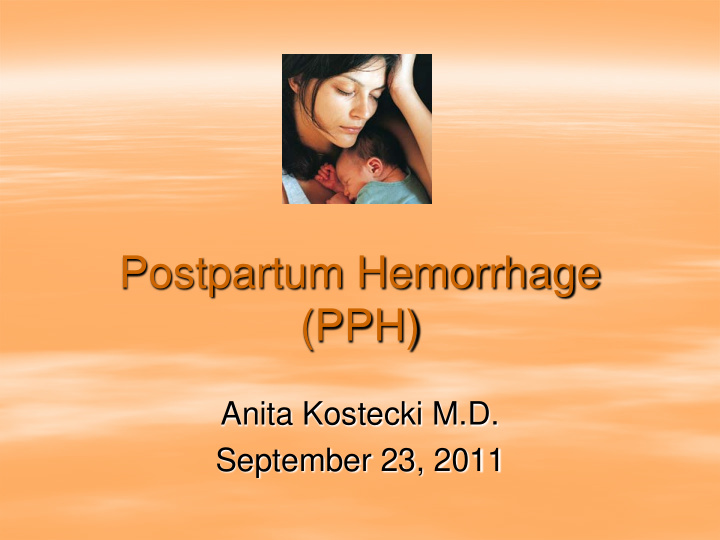



Postpartum Hemorrhage (PPH) Anita Kostecki M.D. September 23, 2011
Learning Goals for PPH Recognize risk factors and etiologies of PPH Outline active 3rd stage management Recognize PE s/s postpartum hemorrhage Perform initial maneuvers in response suspected PPH Appropriately choose and use pharmacologic agents for PPH Recognize when pharmacologic agents are not adequate treatment and what to do next, including appropriate communication re: consultation
PPH Definitions Vaginal delivery > 500 cc – Unclear what EBL actually is after normal VD – PPH = bleeding >normal in “eyes of the beholder” C/S > 1000 cc Amount requiring transfusion 10% reduction in Hct Symptomatic blood loss Primary—within 1 st 24 hrs Secondary—after 24 hrs (delayed PPH)
Estimation of Blood Loss Comparison to known quantities – 12 oz Diet Coke = 350 cc – 20 oz Venti Starbucks = 500 cc – ½ gallon of milk = 1900 cc Adding measurement tools on L+D – Standardize weighing of pads – Using graduated collection containers – Posting visual aids as reminders % soaked lap pads>translate to specific ccs
Clinical Classification of Blood Loss Class I—EBL up to 1 L no VS changes Class II—EBL 1-1.5 L (mild shock) – Slightly low BP and HR elevation Class III—EBL 1.5-2L (mod shock) – SBP 70-80, tachy, pallor, restlessness Class IV—EBL >2 L (severe shock) – SBP 50-60, more tachy, dyspnea,collapse Use of VS as “triggers” for rapid response
Risk Factors for PPH Anything that makes the uterus bigger or tired – Multiple gestation, polyhydramnios, LGA fetus, >4 prior births, fibroids, prolonged 2 nd stage, MgSO4, chorioamnionitis, augmentation, precipitous labor Previous or evolving hematologic abnormalities – Hct<28, plts < 100, bleeding d/o, +AB screen Placental problems – Low lying, previa, abruption, retained, acreta,etc Prior or current c/s (esp c/GA), episiotomy Use of RF to stratify pts prior to delivery – Need to be prepared for PPH in any delivery (18>3%)
Active Management of 3 rd Stage Cochrane Meta Analysis – 62% fewer PPH in Active vs. Expectant 3 rd stage management groups Components of Active Management – Oxytocin 10 units IV/IM with delivery of infant or placenta (reduces PPH by 40%) – Controlled cord traction – Cord clamping c/in 2 mins – Fundal massage after delivery of placenta Need for hospital-wide guidelines
Uterotonic Agents Pitocin 20-80 units in 1L chrystalloid – Hypotension c/IV bolus of med alone Ergot--Methergine 0.2 mg IM – Contraindicated c/Htn; SEs: N/V Prostaglandins – Carboprost (Hemabate) 250 mcg/1 amp IM-max 2 mg Contraindicated in asthma; max dose 2 mg – Misoprostol (Cytotec) 800-1000 mcg PR/other routes – SEs: elevated temp, N/V, diarrhea, flushing, tachycardia, shaking, BP changes
“Move Up/Move On” If no response to one med, move on – Be sure bladder emptied IV pitocin>methergine>prostaglandin – No clear benefit to 2 prostaglandins as mechanism of action same – Concurrently increase IV access and order T+S, O2 If atony not responding to any med, move on to non-pharmacologic rx – T+C RBC and request FFP/plts/cryo, DIC screen – Intrauterine balloon (Bakri) – Special sutures at time of c/section (B Lynch) – D+C>hysterectomy (Uterine artery embolization?)
When to Consult When atony is not quickly responding to 1-2 agents When picture is mixed or etiology uncertain When technical assistance is needed for further assessment or treatment Prior to patient becoming unstable – Value of “head’s up” if moving in that direction
Summarize for Consultant Any risk factors for PPH How long since placental delivery – Placenta intact? – Lacerations? What you have tried so far Pt’s VS/any sxs Anesthesia/IV status What has been ordered
Initiatives at UMass for Improved Response to PPH Improved nursing education re: active management of the 3 rd stage Do not need written order for any PPH med in PYXIS (can overide all) PPH cart for post partum areas Massive hemorrhage protocol
Importance of Drills/Simulation “Medicine is the last high-risk industry that expects people to perform perfectly in complex, rare emergencies but does not support them with high- quality training and practice throughout their careers” -Paul Preston, MD
Recommend
More recommend